Drawings from the camps in the occupied Dutch East Indies (1942-1945) > Living and working
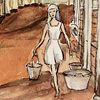
When it came to the internment of men, the Japanese showed a marked preference for existing prisons. Often these prisons had first to be emptied in order to accommodate the new residents, but sometimes the men had to live in close contact with ordinary detainees. For women, there was more variation: schools, hospitals, barracks, fenced-off city neighbourhoods, coolie sheds. Sometimes, but certainly not always, the buildings were run-down en had already been declared unfit for human habitation. Often, the internees had to pay rent. Even in the beginning, the men were forced to work for the Japanese in some camps. In Cimahi, for instance, men were set to work in the airfield. Starting in 1944, the men had to work for the Japanese army almost everywhere.
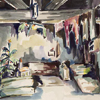
The Japanese saw to it that the camps cost them as little as possible., The inmates were therefore expected to take care of everything they needed themselves. Furniture, tools, tableware, cooking utensils, the internees had to bring along everything or to make, buy or borrow whatever they lacked.
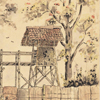
In the beginning, the camps were not entirely cut off from the outside world. In Java, women were even allowed to leave their camp once or twice a week, but this relative freedom was progressively curtailed as time passed on. At first, the entrance gate remained open, with policemen standing guard. Later on the gate was closed. Barbed wire was put up around the camps, in the course of time to be replaced by a gedèk, a wall of interwoven bamboo stalks. From these bamboo walls stems the expression gedèkken, wheeling and dealing by the inmates with the locals through the openings in order to supplement their meagre rations. They were severely punished if they got caught.
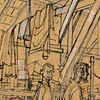
In Java, the women were housed in city neighbourhoods or blocks, the so-called protected districts, where they had a fair amount of space at their disposal until mid 1943. In Jakarta (then Batavia) five or six people lived in a house with three or four rooms. However, there were camps where the situation was much worse from the onset. In Palembang for instance, the first camp for women and children, there were 24 people to a house of a similar size. Starting in the second half of 1943, when ever more camps were merged, the situation became much worse, all the more so if the camp’s total surface area was reduced. In the end, it was no exception for one person to have no more than fifty centimetres of sleeping space at his or her disposal. Living conditions were extremely bad, especially in the barracks. The barracks, made of wood, bamboo and leaves of the atap palm, were poorly built and deteriorated quickly, while there was hardly any material available for repairs.

Many camps lacked sufficient toilets. Inmates had to queue up or walk a long distance. At night, most of them used a chamber pot. The drainpipes often clogged up in the houses that served as camps. The cesspits regularly ran over and had to be emptied; cleaning out the filth was part of the chores. The water supply was turned off in most camps starting in 1944. Water then had to be fetched at a central point. The inmate had to be extremely careful with water when washing themselves and their clothes; there was no more soap to be had by that point.

The many relocations and camp mergers entailed an equal number of transportations. Of these transportations, those made by sea, frequently in overcrowded ships, were by far the hardest. Land transportation took place by train as much as possible. Travelling by train, mostly in fourth-class carriages, often took much time and was extremely uncomfortable. En route, the internees were forbidden to have any contact with the native population or to buy anything. More often than not, they did not get anything to eat during the journey. In the beginning, everybody was allowed thirty kilos of luggage, mattresses, kitchenware and some cutlery. This allowance was reduced later on. During the transportations, the internees lost part of their belongings and often their best friends as well. If the camp was new, it had first to be cleaned on arrival. Moreover, the whole camp organization had to be set up from scratch. In the case of an already existing camp, the fresh arrivals had to make a home for themselves and adapt to new rules and new room or barrack mates.
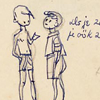
In the camps, the children stayed with their mother, who tried to raise them in as normal a way as they could. There was even a chance to offer them some schooling. But the children also had chores to do: cleaning, gathering wood, looking after the sick. They played with whatever they had been able to take along from home or with self-made toys. Mothers and the somewhat older children made picture books and books to read from. There were also home-made games. Whenever paper and pencils were available, the children made drawings. And then there were youth clubs and handcraft clubs, as well as lessons in singing or folk dancing. At first, boys remained with their mothers in the women’s camp until they were 16 years, but starting in 1944, they were taken to camps for boys or men from the age of ten onward. From then on, they had to provide for themselves and they had their own chores: collecting refuse, helping others to move, carrying corpses. They got more and more expert at smuggling and pinching something extra to eat.

In the beginning, interned men were forced to work for the Japanese in some camps. In Cimahi for instance, men were put to work in the airfield. Starting in 1944, internees were forced to work for the Japanese army almost everywhere. The men had to work on the land and in the docks, to help build railway lines, like the Thai-Burma and the Pakanbaru lines, or they were sent to work in Japanese mines. The women had to sew soldiers’ uniforms and make ropes or wooden nails for ships. Starting in 1944, the upkeep of vegetable gardens became compulsory. Not only did the Japanese expect the camps to be as self-supporting as possible, part of the gardens’ yield had to be tuned over to the Japanese on behalf of the army. In some camps, the internees had to breed pigs for the Japanese. They were paid for their work, namely 15 guilder cents a day.
>> Read on: Food and health care
<< Go back to: Life in the camps
